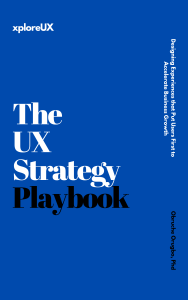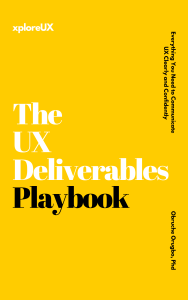
In today’s hyper-competitive digital landscape, adopting a user-first design approach isn’t just a noble UX ideal – it’s a proven growth strategy. When companies practice user-first design, they create products that delight customers, reduce friction, and ultimately drive key business metrics like revenue, conversion rates, and retention. On the flip side, neglecting the user experience can derail even the most promising business models. For example, MySpace – once the leading social network – infamously lost its user base in part due to a cluttered interface and poor user experience, driving frustrated users to a cleaner competitor. Startups and market leaders alike have learned that user-first design is not just about happy users, but about aligning the product with business goals to accelerate growth.
UX and business objectives are often two sides of the same coin. In fact, many areas of focus overlap between the two as the simple diagram below suggests. A user-first design approach seeks that sweet spot, creating solutions that delight users while also meeting key business KPIs like retention and growth.
This thought-leadership guide will outline actionable user-first design strategies that accelerate business growth. We will explore how aligning UX with business objectives leads to measurable outcomes, drawing on current trends in SaaS, e-commerce, and mobile applications. From streamlining onboarding flows to embracing inclusive design, each strategy below demonstrates how designing for the user also drives key business goals.
Every successful user-first design strategy starts with deeply understanding your users. Insightful user research – through interviews, surveys, usability tests, and analytics – uncovers what your customers truly need and where they encounter friction. Designing with empathy means your product not only solves the right problems, but also feels intuitive and helpful to the people using it. By investing in user research early and often, companies avoid building features in a vacuum that don’t resonate with users.
Ignoring this step can be costly. Teams that skip research often waste time on features nobody uses, leading to low adoption and churn. In contrast, when products are crafted around validated user needs, the payoff is tangible. They simplified the process and added clearer guidance; as a result, churn plummeted from 8% to 2% within months and even support tickets dropped significantly. This kind of retention boost has a direct impact on revenue – retaining just 5% more customers can increase profits by 25% to 95% according to Bain & Company.
Empathy-driven design also ensures you’re solving the right problems – the ones that align with both user needs and business goals. A user-first design approach means product teams continuously ask, “What is the user trying to achieve, and how can we make it easier?” By mapping out the user’s journey and pain points, you can prioritize UX improvements that also support key metrics (for example, smoothing out a signup flow to increase conversion, or improving in-app navigation to boost engagement time). When you ground decisions in real user insights, you create experiences that feel tailor-made for your audience. In turn, casual users become loyal customers – a transformation that drives word-of-mouth and sustainable growth.
First impressions in software are critical. If your onboarding process or primary user flows are confusing or frustrating, users will simply walk away – and the business loses potential revenue. That’s why user-first design focuses heavily on streamlining the critical paths that users take from the moment they sign up or begin a task, ensuring those paths are as smooth as possible. Eliminating unnecessary steps, guiding the user with clear cues, and providing help at the right moments can dramatically improve conversion rates and retention.
Consider the checkout process of an e-commerce app or the sign-up flow of a SaaS product. Each extra form field, page load, or unclear instruction is an opportunity for users to drop off. By simplifying these flows, companies can recover huge amounts of would-be lost business. Baymard Institute estimates that optimising checkout flows can boost conversion rates by 35%, translating to $260 billion in recoverable sales in the U.S. and EU alone. A user-first strategy will scrutinize every step of the key journeys and ask, “Is this step absolutely necessary? How can we make this easier or faster?”
One actionable tactic is to implement progressive onboarding – gradually introducing features and guidance as the user needs them, rather than overwhelming them up front. Many successful SaaS apps use tooltips, interactive tutorials, or even AI-driven chat assistants to help users get set up quickly. The business impact of improving onboarding can be huge. A smoother onboarding not only increases the percentage of users who convert from free trials to paid subscriptions, but also accelerates the time to value, which keeps new customers engaged. In the SaaS world, reducing time-to-value by simplifying onboarding has been linked to higher trial conversion and lower churn, directly affecting monthly recurring revenue.
The evidence for streamlining UX is compelling. When a user-first redesign turned a convoluted 8-step sign-up into a 2-step process with clearer calls-to-action, one startup saw its conversion rate jump and churn drop by several percentage points. In e-commerce, eliminating distractions and simplifying checkout (for example, offering a guest checkout or one-click payment options) leads to more completed purchases – directly boosting top-line sales. With a user-first design mindset, you relentlessly trim needless complexity and guide users through the happy path, removing barriers that prevent them from doing business with you.
A core principle of user-first design is meeting users where they are – and today, they are often on mobile devices and expect instant, effortless interactions. In user-first design, performance and accessibility are not just technical concerns – they define the user experience. Fast, responsive, and universally accessible products keep users engaged and open your business to the widest possible audience.
Speed matters. Users will abandon even a product they like if it feels sluggish. Nearly half of visitors will leave a website that takes more than 3 seconds to load. And mobile users are even less patient – they are five times more likely than desktop users to quit tasks if a site isn’t optimized for smaller screens. The business cost of a slow or poorly optimized experience is huge, but on the flip side, a well-tuned, fast interface keeps customers moving through funnels.
Mobile-first design is a must for modern UX strategy, especially as mobile commerce and app usage continue to skyrocket. In the first quarter of 2023, 63% of online purchases were made on mobile devices. Ensuring a seamless mobile experience (through responsive design or high-quality native apps) will capture this majority segment of users and revenue. Adopting a responsive, mobile-optimized approach as part of your user-first design means your content, buttons, and forms are all easy to use on a small touchscreen. The reward is clear: mobile-friendly sites have significantly higher engagement and conversion rates than their non-optimized counterparts.
Equally important is accessibility – designing experiences that are usable by people of all abilities. An inclusive design not only fulfills ethical and legal obligations, but it also expands your market reach. Approximately 26% of adults in the U.S. have a disability; accessible design ensures you’re not excluding this significant audience. Yet 71% of users with disabilities will leave a site that’s hard to navigate for them. By implementing accessible UX practices (proper color contrast, screen reader support, keyboard navigation, captioned media, etc.), you ensure no potential customers are unintentionally turned away. In fact, products with inclusive content see significantly higher engagement (one study found 35% higher user engagement when content was accessible to all). In short, designing for speed, mobile, and accessibility isn’t just altruistic – it directly drives user satisfaction, traffic, and conversions, which all accelerate your business outcomes.
Another hallmark of user-first design is crafting experiences that feel personal, relevant, and even delightful. Users are far more likely to engage with – and stick around on – products that speak to their individual needs or surprise them in positive ways. In practice, this means leveraging personalisation, helpful micro-interactions, and thoughtful design details that collectively enhance the user’s emotional connection to the product. The business payoff of delighting users is loyalty and increased lifetime value.
Personalisation has become a key trend in modern UX, especially in e-commerce and SaaS platforms that gather user data. By tailoring content or recommendations to each user, you reduce information overload and show customers that you “get” them. This leads to more usage and higher sales. The most famous example is Amazon’s recommendation engine: an AI-driven personalised UX feature that accounts for an estimated 35% of Amazon’s total sales. Many SaaS companies similarly personalize dashboards or workflows based on user roles or past behavior, which helps users find value faster and stick with the product. Importantly, personalization should always be done with user consent and transparency to maintain trust – it’s about helping the user, not exploiting their data.
Small design delights also make a big difference. Micro-interactions – those subtle animations or responses when you tap a button or complete an action – provide immediate feedback and can even add a touch of joy. Think of a friendly confetti burst when you achieve a goal in an app, or a button that playfully bounces to acknowledge a click. These moments humanize the digital experience and reinforce positive behavior. While the impact of delight is harder to quantify than pure speed or ease-of-use, it shows up in retention and word-of-mouth. Satisfied users are more likely to become repeat customers and recommend your product to others. (In fact, nearly a quarter of online shoppers will share a positive experience with at least 10 people – a reminder that delighting one user can multiply into many new users via referrals.)
To implement this strategy, consider features like saved preferences, intelligent defaults, and dynamic content. In e-commerce, providing personalized homepages or promotions based on browsing history can increase basket sizes and conversion rates. In mobile apps, haptic feedback or fun loading animations can make the interface feel more responsive and alive. Across all domains, ensure your tone and microcopy speak the user’s language – good UX writing can make a product feel like it was designed just for them.
Ultimately, a personalized and delightful experience deepens engagement. Users who feel an app or service is practically “made for them” will use it more and stick with it longer, directly improving metrics like average revenue per user and customer lifetime value. By designing not just for utility but also for enjoyment, you strengthen the emotional bond between user and brand – a powerful driver of sustainable growth.
User-first design is not a one-time project – it’s an ongoing discipline. The best product teams treat their UX like a living, evolving asset: they continuously gather user feedback, test new ideas, and iterate on the design to better serve users and meet business goals. This data-driven refinement ensures that your product keeps up with changing user expectations and market conditions, and it often uncovers opportunities for breakthrough improvements.
Establish clear UX metrics that map to business outcomes – for example, task completion rates, drop-off points, or customer satisfaction scores. By tracking these, teams can spot issues and test improvements. If users abandon a form at a specific question, that’s a cue to simplify it and perhaps A/B test a new design to see if conversions improve.
The value of continuous iteration is well documented. One online gaming company found that a small usability improvement on its homepage led to a 25% increase in sales, a massive revenue jump from a seemingly minor design tweak. Moreover, the company discovered that improvements beyond those small tweaks had diminishing returns, helping them avoid wasted effort. In a similar vein, a design-driven mindset can prevent costly rework: early user testing often catches issues that, if left unaddressed, would require expensive fixes after launch. Design changes in a user-first design culture are treated as hypotheses to validate, rather than one-and-done decisions based on gut feeling.
For startup founders and product leads, fostering a test-and-learn mindset pays off in both user satisfaction and ROI. Consider implementing regular usability testing sessions, heatmap analysis on key pages, and feedback loops such as in-app surveys or periodic user interviews. When users see their feedback lead to improvements, it builds trust and loyalty. Internally, celebrating UX wins, like a boost in engagement after a redesign, helps keep the team aligned on the importance of user-first design. By continuously iterating, you essentially let your users co-create the product with you over time – making the experience more closely aligned with their needs. In a fast-changing market, this ability to adapt and refine is another reason why user-first design strategies are so crucial for long-term success.
In an era where customers have abundant choices and little patience, user-first design is the differentiator that can catapult a business ahead of its competition. By designing experiences that put users first, companies inevitably end up advancing their own goals: conversions climb as friction falls, retention increases as satisfaction grows, and new opportunities emerge as you truly understand your audience. The strategies outlined above – from rigorous user research and streamlined onboarding to performance optimisation, personalisation, and continuous iteration – all demonstrate how doing right by the user is also one of the smartest business investments you can make.
Crucially, adopting a user-first design mindset requires commitment from leadership. It means measuring success not just in traditional KPIs but also in user-centric metrics, and making cross-functional UX a priority. The payoff is well worth it: businesses that champion UX have seen massive returns. In practical terms, this could mean the difference between a product that stagnates and one that achieves viral adoption because users genuinely love using it.
For startup founders and product decision-makers, the message is clear. UX is not just about making an app look pretty or a website easy to navigate – it’s about designing an experience that solves real problems in an enjoyable way. That experience is your product, and it is directly tied to your business outcomes. By implementing user-first design strategies, you ensure that every product decision is guided by what will delight your customers and, as a result, drive your growth. In the long run, the companies that win are those that never lose sight of their users. Put users first, and accelerated business success will follow.
- Parallel HQ – Why UX Design Strategy Is Important (2025)parallelhq.com parallelhq.com parallelhq.com parallelhq.com
- CMSWire – UX in the Hot Seat: Make the Business Case for User Experienceparallelhq.com parallelhq.com
- UserGuiding – UX Statistics and Trends (2025)userguiding.com userguiding.com userguiding.com userguiding.com
- Forbes – How UX Is Transforming Business parallelhq.com (citing Forrester Research)
- VWO – Top 10 CRO Case Studies vwo.com
- McKinsey – The Business Value of Design mckinsey.com
- IBM (via IBM.com) – Recommendation Engine Impact ibm.com
- Baymard Institute – Mobile UX Benchmark 2024 parallelhq.com
- Shopify – AR Shopping Trends (2024) shopify.com
- Pew Research (via UXmatters) – Digital Trust Survey 2023userintuition.ai uxcam.com
- Cisco Consumer Privacy Survey 2024 (via UXCam)uxcam.com
- UserGuiding – UX Statistics and Trends (2025) userguiding.com (chatbot adoption)







